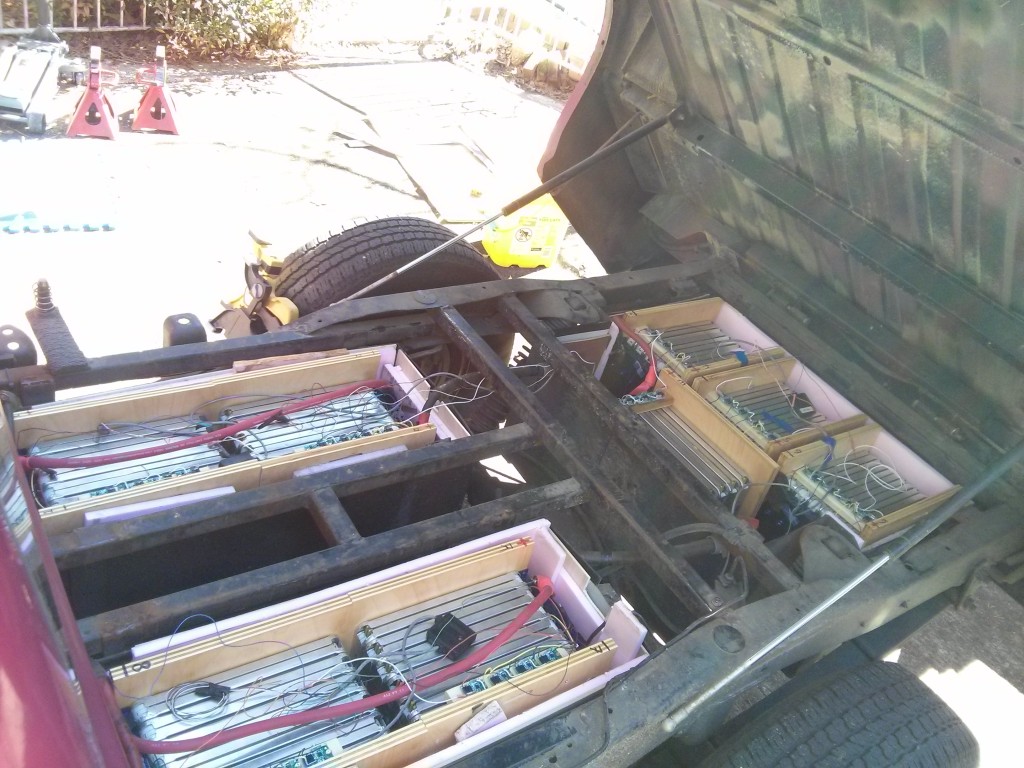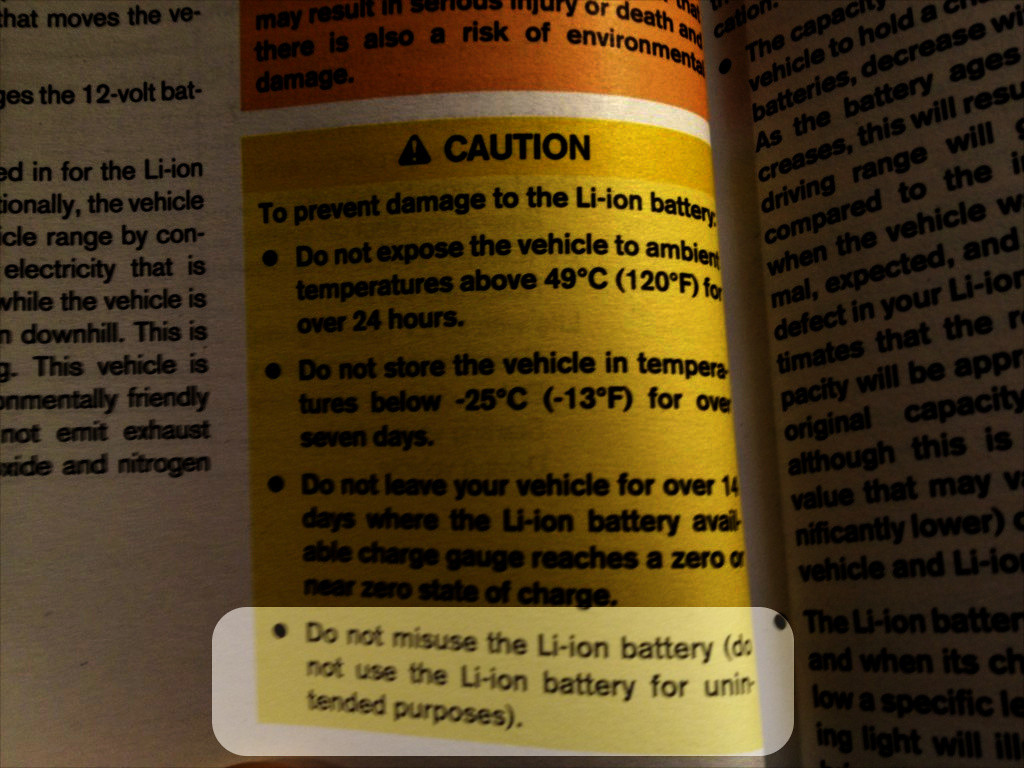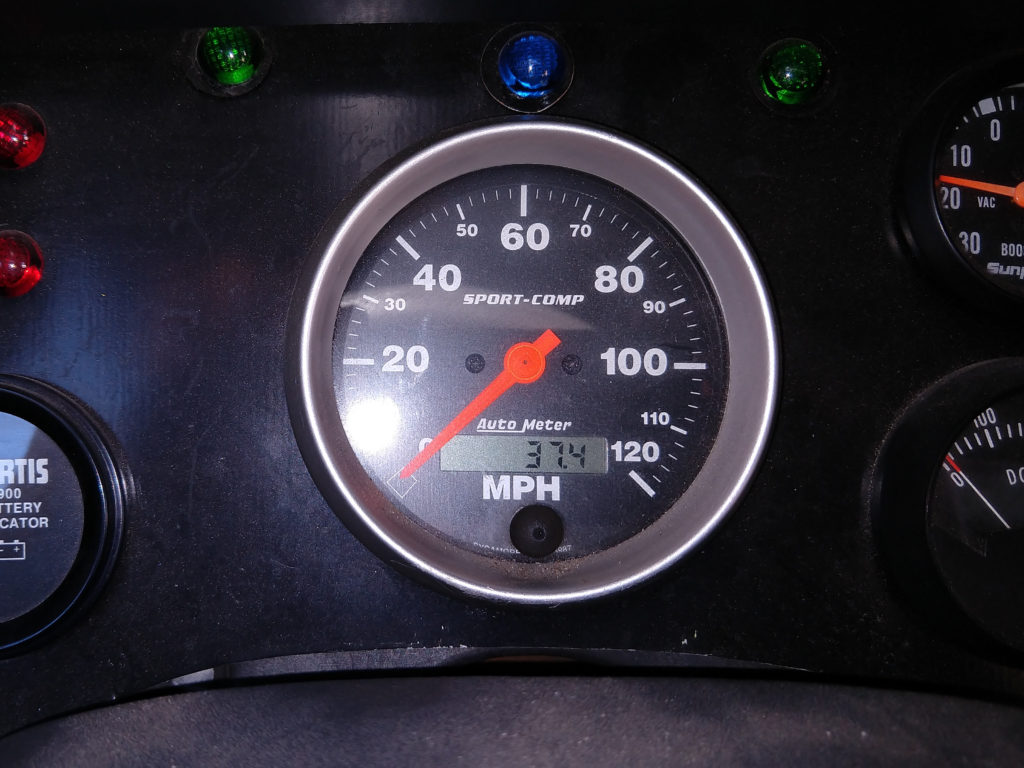I have successfully driven my S-10 Electric Pickup conversion powered by 48 modules from a salvaged Nissan Leaf battery pack. I have them wired in series, 16 sets of 3 parallel modules, providing 128 volts with 180Ah capacity (23 kWh).
It took me a full three days of work to make the swap and get the truck to a barely drivable condition. I have the cells hooked up with a warning buzzer on the BMS low voltage loop signal, but I do not yet have the charger fully connected. I anticipate another 8 hours of work to get the charger and pakTrakr system fully set up.
From a performance standpoint, the LiIon modules are much “stiffer” than the twenty 6V golf cart batteries they replaced, meaning that they do not suffer from as much of a voltage sag under high current draw. The lowest I was able to get the voltage to sag on the LiIon modules was down to 118 volts while accelerating up a very long steep hill at a 350+ Amp draw.
My 0 to 35 mph time is a respectable, but not exactly sporty, 9 seconds, limited now by my motor and controller instead of the batteries. (Anybody have a Zilla 1K they want to sell?)
The ability to accelerate from 35 to 50 MPH up a long steep hill is much better subjective performance than I was able to get out of the truck when using golf cart batteries. It helps that the 500 lbs of Nissan leaf modules are replacing 1200 lbs of golf cart batteries, so the truck is 700 lbs lighter now. This also improves the stopping distance. The handling is slightly lighter, but nothing is going to make an S-10 into a sports car.
Because I got a good deal on a wrecked leaf, and reduced my costs by parting out the rest of the car, the actual LiIon modules only cost me $1200 (less than a set of new golf cart batteries)! However, the overall upgrade cost me $4100 once I included the cost of a new charger, EVSE, and BMS system to support the LiIon batteries, plus all of the miscellaneous materials and tools I needed to build the batteries and cables. Not to mention the hundreds of hours of work. If I sell some of the old Lead Acid batteries I may slightly reduce that cost.
If you want to watch the entire job, I have an hour long video that has most of the action (at 16x real time), but it’s only recommended for people who really want all the gritty details. I’ve made another post with photos documenting the highlights of the upgrade process.
To make it more enjoyable to watch, please consider the following drinking game:
Take a sip every time:
- I speak to the camera
- I have to use my Flex-Shaft mechanical pickup tool to retrieve something I have (accidentally) dropped (mostly nuts and washers)
- I (deliberately and repeatedly) bring a rapidly spinning table saw blade within 1/2 inch of 2.8 kWh worth of LiIon batteries.
Take a full drink when:
- I drop a battery
- I cause a large electrical spark
update: I edited the above video down into a “shorter” 28 minute version, that leaves out all of the boring mistakes and repetitive work. (it leaves in the exciting mistakes…)






Pingback: Lead Acid to Nissan Leaf Pack upgrade process | Jay's Technical Talk
Pingback: Community Corner — January 12, 2016: The Featured Projects from last Week « Adafruit Industries – Makers, hackers, artists, designers and engineers!
What a great resource you’ve created here. Thank you!
I know it’s been awhile but do you recall or have access to specifications for the gas lift assist cylinders you used for the hinged truck bed? Manufacturer part number, collapsed & extended lengths, load rating?
Thanks again!
Sorry, I don’t have exact specifics, basically just two air shocks and a hinge. I have a camper topper installed, so it’s a bit harder to lift up now, if I were to do it again I’d probably go with a dump bed kit that had electric actuation, something like this:
https://amzn.to/2GqMHFB
Pingback: Running our 240 volt Well Pump in a power outage | Jay's Technical Talk
What are you getting for usable range with the conversion?
Thanks,
J
See:
https://www.summet.com/blog/2016/03/13/how-far-can-it-go/
I haven’t tested it lately, but it’s still at least 35 miles.
What a delight to find your webpage! I have skimmed a few pages and get the gist that you have a S-10 lead-acid EV conversion, and then you upgraded that by getting a Nissan Leaf and upgrading to that lithium ion 24kWh pack. This is what I’ve been searching for! I was an early adopter EV buyer in 2011, one of the first Nissan Leaf buyers. I have wanted to convert my 1985 Nissan 720 pickup for the longest time. I haven’t committed to it yet because of financial concerns and just a general lack of knowledge (I know EVs; I just don’t know EV conversions). My goal is to increase performance of my mini, and my plan was to lay two 24kwh Nissan Leaf packs under the bed. I was researching tilt beds when I ran across your page. I was also thinking of getting a wrecked leaf to pull not only the batteries but also the charger, controller, motor, essentially everything related to making it go EV. Since I have a Leaf I thought that at some point I would need to upgrade/replace the pack in the car, and if I took the old pack and added it to a wrecked Leaf pack I’d have a decent range pack. But since I want to opt toward performance I figure I’d have to either “open up” the voltage delivery to the stock motor or I would need to change to an aftermarket motor like a warP-11. I’m going to read over your pages here more fully and watch all your videos to get my head around what you have accomplished. Thanks so much!
Pingback: Salvage 2013 Nissan Leaf modules – 7 year old range update | Jay's Technical Talk
Pingback: Salvage 2013 Nissan Leaf Modules – 8 year age capacity test: 75-80% | Jay's Technical Talk